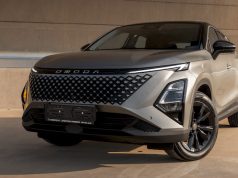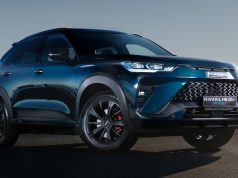The Lexus RX has entered its fifth generation with a brand-new design, new powertrains, greater performance, refined luxury, impressive safety and a plug-in hybrid model.
Lexus says it has optimised the the RX’s fundamentals such as the centre of gravity, mass, rigidity, and powertrain “to create a more natural dialogue between car and driver”. This is a cornerstone of the new RX – the car ‘shrinks’ around the driver, providing a nimble driving experience that belies its size. The improved handling and responsiveness are founded on a development of Lexus’ GA-K platform that delivers enhanced body rigidity and a low centre of gravity.
The new RX comes with a line-up of four powertrains of which three are electrified.
- At the core of the brand’s offering, the RX 450h+ is the first RX to adopt Lexus plug-in hybrid technology.
- Lexus positions the RX 350h hybrid as an efficient alternative to lower displacement diesel and petrol powertrains.
- For customers seeking something exhilarating, Lexus is introducing its first performance-focused turbocharged hybrid, the RX 500h.
- The first rung on the RX ladder is occupied by the RX 350, sporting a 2.4-litre turbocharged inline-four petrol engine.
Exterior design
With the new design, the spindle shape from the Lexus grille morphs into the new ‘sinewy’ body, integrating the shape into the front of the vehicle. This creates a ‘killer whale’ profile, according to Lexus. The slim headlight units and a wider front track add emphasis to the car’s lower centre of gravity and planted look. While the new RX has the same overall length as the current model, the bonnet has been elongated. The A-pillar moved further back and the wheelbase was extended by 60 mm. Sculpted surfaces on the door panels and 21-inch wheels (standard size across the range) add a sense of “powerful traction and dynamism,” Lexus states.
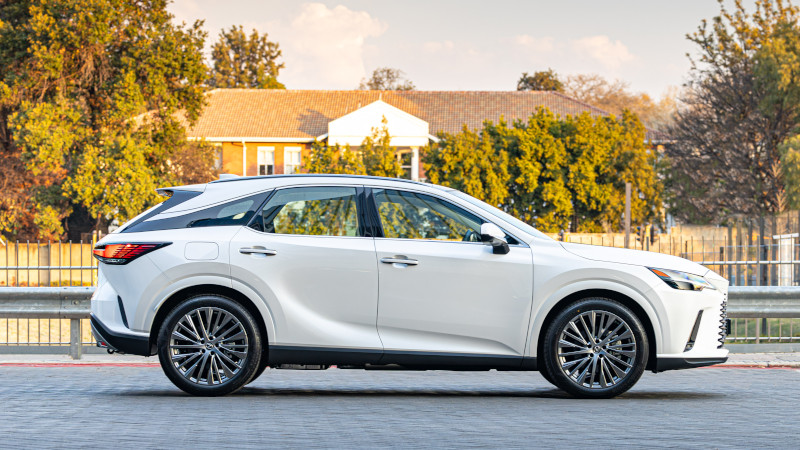
The RX’s characteristic “floating roof” effect created by blacked-out rear-pillars is retained but given a stronger three-dimensional appearance. “The rear of the car communicates a sense of power with a shorter overhang, wider track (+45 mm) and a sweeping transition from the wings round to the taillights,” according to the manufacturer.
F Sport models feature a bespoke front bumper that expresses a wide and low stance and contributes to aerodynamic performance. F Sport also gains exclusive, multi-spoke, black gloss aluminium wheels. The grille features an exclusive mesh pattern and has a seamless design that fuses the boundary between the body and the mesh grille, establishing a unique F Sport identity.
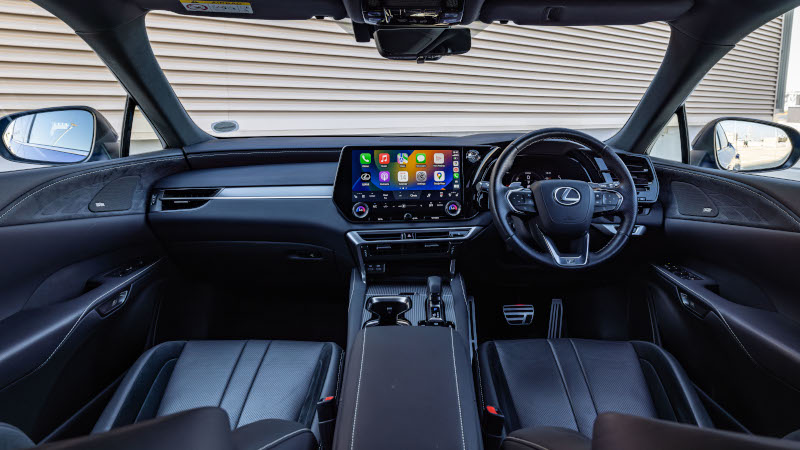
‘Tazuna’ crafted cockpit
The theme of simplicity complements Lexus’ “tazuna” concept for the driver’s cockpit. This rationalises the location and ease of use of the controls and information sources, so that the driver focuses on driving. The tazuna approach is visible in details such as the head-up display and new multimedia system. The large, 14-inch touchscreen and the provision of physical buttons for frequently used functions help minimise driver head movement.
Leveraging Lexus’ safety technology, the RX benefits from the third-generation Lexus Safety System+, with an improved Pre-Crash System. It is also available with Lexus’ Safe Exit Assist, a feature which debuted in the new NX. Linked to the electronic door release, it prevents doors being opened into the path of vehicles or cyclists approaching from the rear.

The list of standard equipment is long, but some of the more uncommon bits of standard items includes a 21-speaker Mark Levinson audio system and Heads Up Display.
The design provides more knee room for rear seat passengers and access is easier than before. The rear load compartment matches the retiring RX for capacity, despite the new model having a shorter rear overhang. Cargo volume is 612 litres with the rear seats in place. This gives enough space to carry four golf bags or two 77-litre and two 63-litre suitcases.
Powertrains and performance
A range of powertrains includes an accessible and efficient full hybrid electric model, a completely new turbocharged performance hybrid and the first plug-in hybrid electric RX.
RX 450h+
“The RX 450h+, the very first plug-in hybrid electric RX is a game changer in terms of the Lexus electrification journey. For the South African market with its ever-present electricity supply problems and fledgling charging network, there is no better option,” said Glenn Crompton: Vice President of Lexus Marketing.
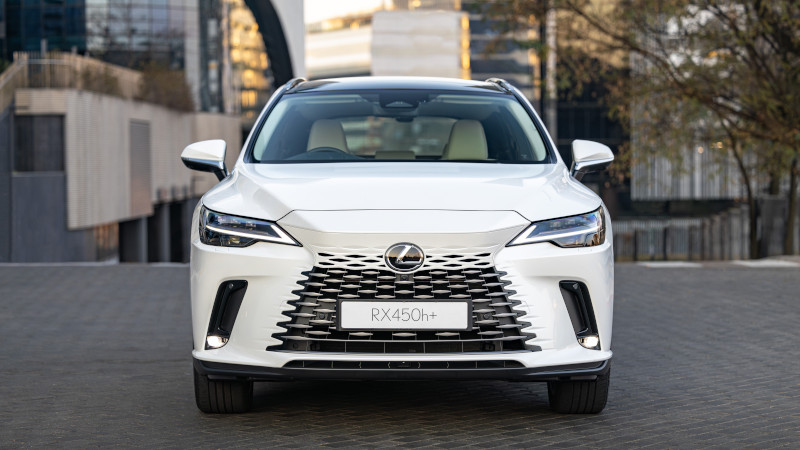
The RX 450h+ can achieve a limited electric range with a battery that can be recharged using a charger. An EV driving range of 65 km (enough for an average daily commute) is possible at speeds of up to 130 km/h. Once the battery charge is depleted, the vehicle switches to its normal hybrid system, maintaining high efficiency. This is in contrast to most other manufacturers’ systems, where the powertrain defaults to its internal combustion engine.
The RX’s plug-in hybrid system uses a 2.5-litre hybrid engine (paired to the Lexus e-CVT system) and a rechargeable lithium-ion battery with 18.1 kWh capacity. An additional rear electric motor enables Lexus E-Four fulltime all-wheel drive. Total output is 227 kW, which enables 0-100 km/h acceleration in a brisk 6.5 seconds. The official consumption average is just 1,3 litres/100km.
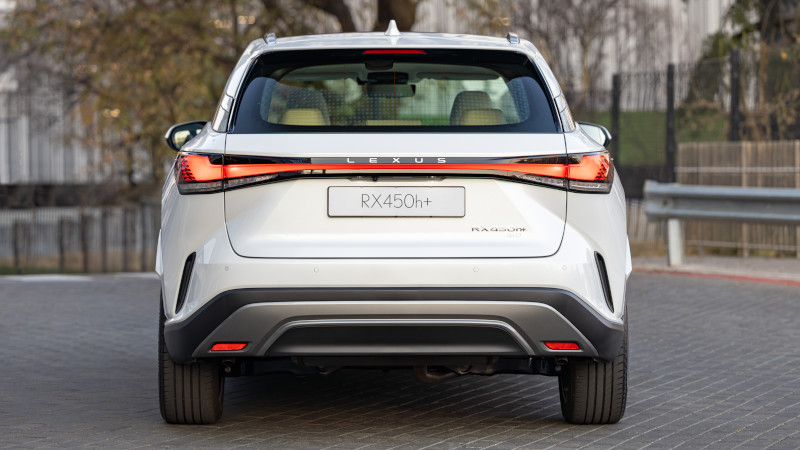
The new, high-capacity lithium-ion battery is housed beneath the cabin floor. The RX 450h+ has a 6.6 kW on-board charger. With a 230V/32A connection, a full battery recharge takes about two hours and 45 minutes, according to Lexus.
RX 500h
With the RX 500h, Lexus has shifted the focus from optimum efficiency to produce a model with a performance edge.
It uses a new parallel hybrid architecture, featuring a 2.4-litre turbo petrol engine and six-speed automatic transmission, integrated front motor and power control unit, hybrid battery and a compact rear e-axle. Total system output is 273 kW and 550 Nm, giving the raciest RX a 0-100 km acceleration time of 6.2 seconds. Petrol consumption is 6,5 litres/100km.
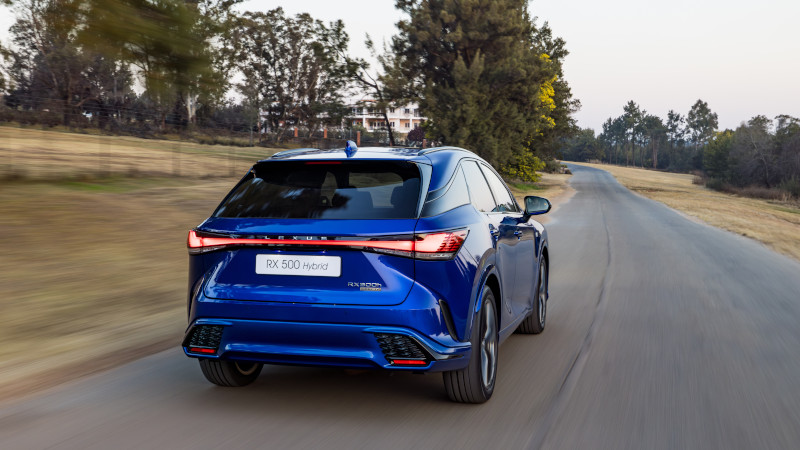
The all-wheel drive system uses a separate electric motor and inverter to constantly balance the power and torque between the front and rear axles. It adjusts the level of the drive force between the two axles – more quickly and precisely than any mechanical system could. “Direct4 communicates a better feel between the road and steering wheel and delivers improved handling stability and driving dynamics at high speed,” a statement from Lexus explains.
Importantly for the RX 500h, it also enhances ride comfort with instant torque that helps control body movement. The driver can experience this in different driving scenarios, for example, a smoother change of direction when entering a bend.
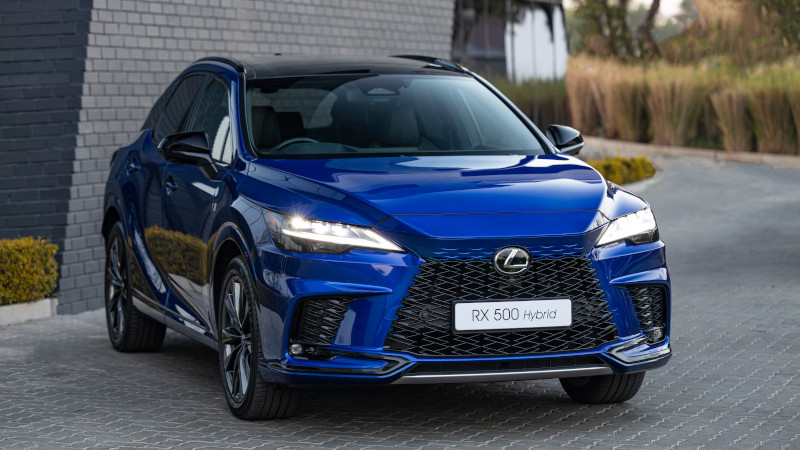
The F Sport Performance with the 2.4-litre turbocharged hybrid powertrain goes beyond the existing F Sport package in the RX 500h (exclusively available in F Sport grade). Significant technical elements contribute to the greater dynamics of the Lexus Driving Signature.
Aluminium six-piston brake calipers are used for the front brakes to provide a linear and direct brake feel. Dynamic Rear Steering (DRS) is also newly adopted to steer the rear wheels up to four degrees in the opposite or same direction as the front wheels, depending on vehicle speed. At low speeds, the system provides excellent turning and manoeuvrability during cornering, achieving a high level of vehicle stability at high speed.
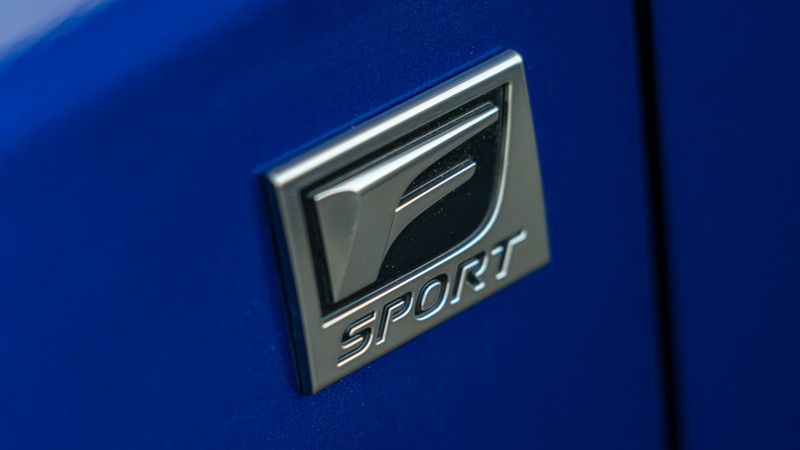
RX 350h
The new RX 350h is characterised by the improved smoothness and efficiency of the Toyota’s fourth-generation hybrid-synergy-drive (HSD) system. This 2.5-litre petrol drivetrain provides 184 kW (total system output) and 0-100km/h acceleration in 7.9 seconds. Fuel consumption is 5,4 litres per 100km. The car is equipped with E-Four electric all-wheel drive.
RX 350
Alongside the afore-mentioned electrified options, there’s also the new 205 kW turbocharged four-cylinder petrol engine. This unit realises higher torque (430 Nm @ 1 700-3 600 rpm) and higher output thanks to advanced technologies like a centre injection system for more stable combustion.
The car’s electronically controlled full-time AWD constantly varies the front-to-rear driving force distribution from 75:25 to 50:50 (depending on situation) to achieve optimal traction. The 0-100 km/h sprint is dispatched in 7.6 seconds. Lexus quotes the average consumption as 8,7 litres/100km.
[mailchimp_list]
Advanced safety
The Lexus adopted the Safety System +3 for the all-new RX. Elements of the integrated safety technology include (over and above the standard active and passive safety features):
- Pre-Crash Safety (PCS) – if the system detects a driver looking away while driving, it warns the driver at an early stage.
- Lane Departure Alert (LDA) – If the system detects a driver looking away while driving, it activates an alert and lane departure control at an earlier time than usual.
- Abnormal driver condition response system – if the driver’s posture is significantly compromised during Lane Tracing Assist (LTA) control, the system judges that it is difficult for the driver to continue driving. It warns others by flashing the hazard lights as the vehicle gradually decelerates. The vehicle is designed to stop within the lane.
Lexus RX pricing
RX350 – R1 424 000
RX 350h – R1 458 300
RX 350h F Sport – R1 543 200
RX 500 F Sport – R1 684 300
RX 450h+ – TBC (Nov. ’23)























